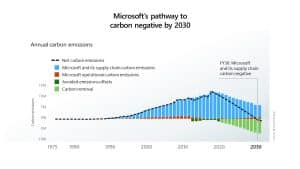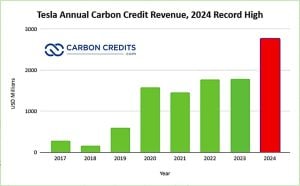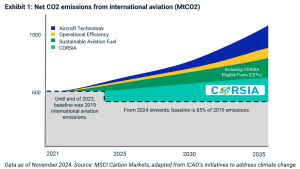Microsoft and Carbon Direct Set New Standards for Marine Carbon Dioxide Removal
Carbon Direct and Microsoft have announced a collaboration to develop a new standard for marine carbon dioxide removal (mCDR). This standard aims to ensure that ocean-based carbon removal methods are high-quality, scientifically sound, and effective in reducing carbon dioxide from the atmosphere.
With the urgency of climate change growing, setting these standards is key. They are essential for the credibility and success of carbon removal efforts.
Carbon Direct helps companies like Microsoft, JPMorgan Chase, and JetBlue reduce their carbon footprint. The company uses science to help them set climate goals, track emissions, and reduce them. They’re also helping those businesses add carbon removal solutions to their plans, making sure their actions have a real, positive impact on the environment.
The Urgency of Marine Carbon Removal: A Vital Tool for Climate Action
The Intergovernmental Panel on Climate Change (IPCC) emphasizes that limiting global warming to 1.5°C calls for drastic reductions in greenhouse gas emissions. The agency also highlights the need to remove large amounts of carbon dioxide (CO₂) from the air.
The ocean, covering over 70% of the Earth’s surface, plays a crucial role in this process. It currently takes in about 30% of human-made CO₂ emissions. This shows its potential as a major carbon sink.
Marine carbon dioxide removal uses different techniques to help the ocean capture and store CO₂ better. Two prominent methods include:
Ocean Alkalinity Enhancement (OAE):
This method adds alkaline substances like crushed limestone or olivine to seawater. This increases the water’s alkalinity. Higher alkalinity helps change CO₂ into stable bicarbonate and carbonate. This process traps CO₂ for a long time.

Direct Ocean Removal (DOR):
This method shifts seawater’s carbonate equilibrium to extract CO₂ as either gaseous CO₂ or mineral carbonates. DOR allows monitoring CO₂ accurately and removes the need for extra materials. However, it is energy-intensive and expensive because of the chemical processes used.

mCDR’s Role in Meeting Climate Goals: The Road to 9 Gigatonnes
The State of Carbon Dioxide Removal report (2nd Edition, 2024) estimates that by 2050, the world has to remove 7–9 gigatonnes (Gt) of CO₂ each year. This is essential to meet the climate goals set by the Paris Agreement.

Presently, about 2 GtCO₂ are removed each year. This mainly happens through methods like afforestation and reforestation. To bridge this gap, innovative approaches like mCDR are gaining attention.
However, scientists warn that relying on carbon removal should not detract from the imperative to reduce emissions. mCDR can help with mitigation efforts, but it can’t replace the need for low-carbon energy systems and better energy efficiency.
Moreover, the natural absorption causes ocean acidification. This harms marine ecosystems. Also, concerns exist about their long-term effectiveness, environmental risks, and measurement challenges.
Improving the ocean’s ability to store CO₂ using mCDR methods could help reduce these impacts and aid in stabilizing the climate. The new standard seeks to address these issues by setting clear criteria for evaluating mCDR projects.
Dr. Matthew Potts, Chief Science Officer at Carbon Direct, remarked:
“mCDR is at a pivotal moment. Achieving high-quality outcomes requires rigorous monitoring, transparency, and scientific integrity to ensure safe and effective deployment…Given the vast spatial scale, the data-intensive nature of ocean-based carbon removal, and the deep connection between these projects and marine ecosystems, clear standards are essential for responsible development.”
As the CarbonCredits team reached out to Carbon Direct for more insights, Antaeres Antoniuk-Pablant, PhD, Senior Decarbonization Scientist, provided meaningful responses to the following questions.
Q. What are the biggest risks associated with large-scale mCDR deployment, and how do these new criteria address those challenges?
A: Human activities already impact ocean chemistry in uncontrolled ways. mCDR offers a controlled, science-based approach that may help ecosystems. The new criteria use models and in-ocean testing to track phytoplankton and marine life health. They also assess community impacts and require proactive engagement with local and Indigenous groups to ensure environmental and social responsibility.
Q. What steps should project developers take to ensure their solutions align with the latest scientific understanding and meet the high-quality standards set by Carbon Direct and Microsoft?
A. mCDR developers must follow strict environmental and carbon monitoring (eMRV/MRV), update methods with new research, and conduct baseline ecosystem assessments. Transparent data sharing and compliance with international laws are essential. Developers should also educate and consult stakeholders, ensuring their projects minimize risks and align with high-quality standards set by Carbon Direct and Microsoft.
A High Bar for Quality: The mCDR Standard Framework
To ensure that mCDR projects are effective and responsible, Carbon Direct and Microsoft have outlined specific criteria focusing on key principles, including:
- Environmental Integrity. Projects must demonstrably remove CO₂ without causing harm to marine ecosystems. This includes assessing potential impacts on biodiversity, water chemistry, and ecological balance.
- Measurement, Reporting, and Verification (MRV). Robust MRV protocols are essential to accurately quantify the amount of CO₂ removed and ensure transparency. This involves establishing baselines, continuous monitoring, and third-party verification to build trust and credibility.
- Durability. The sequestered carbon should remain stored for extended periods, ideally centuries or longer. Assessing the permanence of storage solutions is critical to prevent the re-release of CO₂ into the atmosphere.
- Social Impact. Engaging local communities and stakeholders is vital. Projects should consider social, economic, and cultural factors, ensuring that they do not adversely affect livelihoods and that benefits are equitably distributed.
- Transparency and Verification. Clear documentation and third-party reviews are necessary to maintain accountability.
The addendum to the 2024 edition of the mCDR criteria emphasizes improving the scientific basis for evaluating these projects. It highlights the importance of:
- Baseline Measurements: Establishing pre-project conditions to accurately assess changes in carbon levels.
- Leakage Prevention: Ensuring that carbon removal in one area does not lead to increased emissions elsewhere.
- Ecosystem Impacts: Evaluating how mCDR affects biodiversity, ocean chemistry, and marine life.
- Scalability and Feasibility: Assessing whether projects can be effectively expanded without unintended consequences.
These criteria aim to provide a framework for developing mCDR projects that are scientifically valid, ethical, and environmentally friendly.
Brian Marrs, Senior Director, Energy Markets at Microsoft, noted:
“With rapid technological progress and increased investment, marine carbon dioxide removal has the potential to deliver durable, large-scale CO₂ removal—potentially billions of tonnes per year in the coming decades…By establishing rigorous new mCDR criteria, we aim to help project developers build high-integrity solutions that maximize both environmental and social benefits.”
Microsoft’s Commitment to Carbon Removal: A Leading Example
Microsoft has been actively investing in carbon removal solutions as part of its commitment to becoming carbon-negative by 2030. The company has signed deals for direct air capture and nature-based carbon removal.

In January 2025, Microsoft signed a 25-year deal with Chestnut Carbon. They will buy more than 7 million tons of carbon removal credits. These credits come from forest projects in Arkansas, Texas, and Louisiana.
In addition to forest restoration, Microsoft has explored ocean-based carbon removal methods. In March 2023, the company partnered with Running Tide to remove up to 12,000 tons of carbon through an ocean-based carbon removal system.
These initiatives show Microsoft’s commitment to different carbon removal methods. As such, it helps build a strong carbon removal market. Partnering with Carbon Direct on an mCDR standard aligns with its goal of ensuring that carbon credits and removal projects meet rigorous standards.
The Path Forward for Marine Carbon Solutions
A standard framework for mCDR will build trust in these projects. This will also draw more investment. With better technology and research, marine carbon removal may become key in global climate plans. However, careful implementation is needed to avoid unintended ecological damage.
With this collaboration, Microsoft and Carbon Direct aim to create a science-backed, transparent approach that ensures mCDR contributes meaningfully to climate mitigation.
The post Microsoft and Carbon Direct Set New Standards for Marine Carbon Dioxide Removal appeared first on Carbon Credits.

































